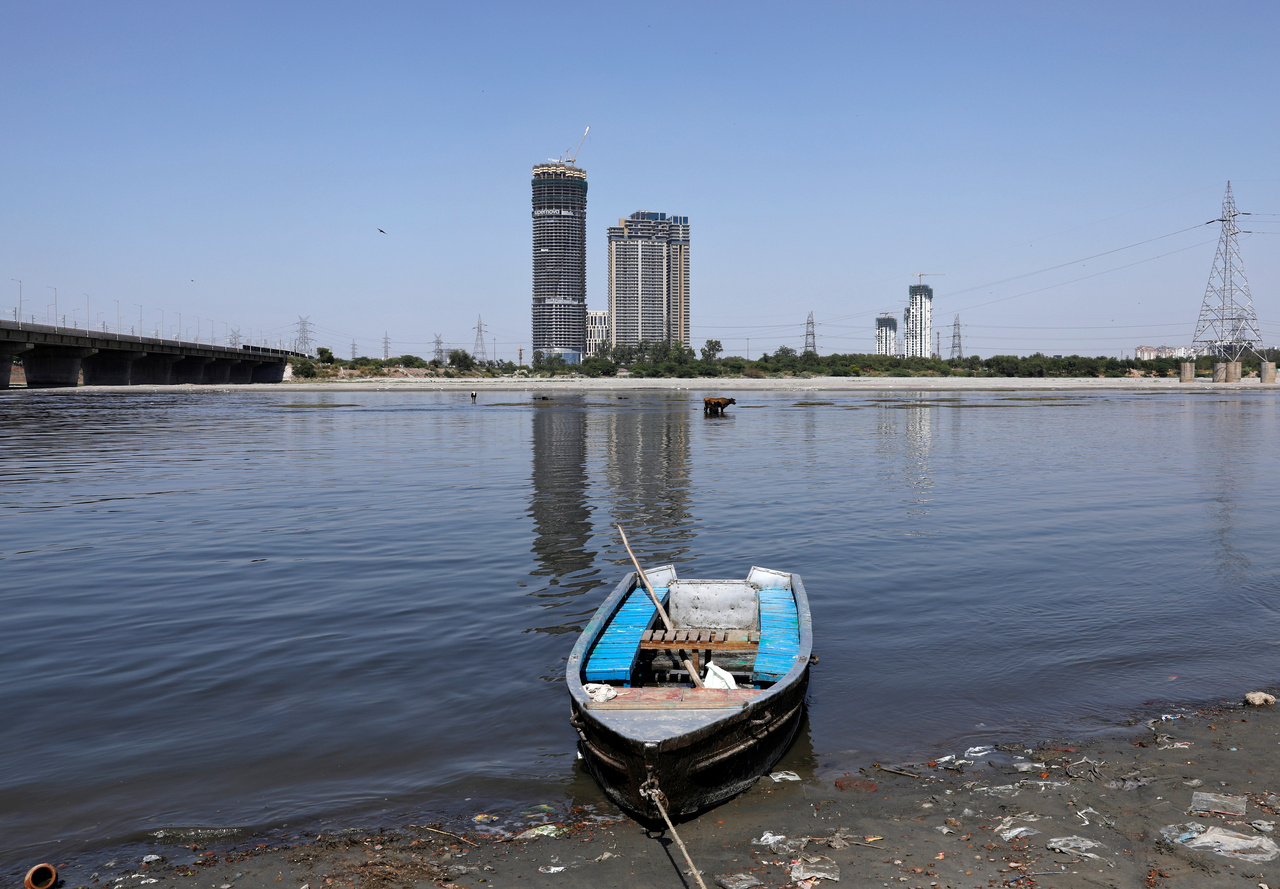COVID-19 SPECIAL
India lockdown reduces pollution in some of the world's most polluted cities
Sign up now: Get insights on Asia's fast-moving developments

A boat is seen on the banks of the river Yamuna in New Delhi on April 8, 2020.
PHOTO: REUTERS
Follow topic:
NEW DELHI - There's a new pastime in India, with many eager to take pictures or videos of the sky from their windows and balconies and share it on social media or on WhatsApp.
One widely-shared video shows people in the northern city of Jalandhar in Punjab, looking from their rooftops at snow-capped mountains, visible in neighbouring Himachal Pradesh state.
In a country where multiple cities often make it to the list of most polluted in the world, clear, blue skies have an unintended but welcome side effect of a three week lockdown to slow the spread of Covid-19.
In Delhi, which frequently tops lists of the most polluted cities worldwide, even the local police is appreciating the clear skies after record pollution levels this winter sent PM2.5 levels nine times over the safe limit.
"Amidst the clear blue skies @DelhiPolice unstintingly performs its duty at pickets," said an account linked to the Delhi Commissioner of Police, describing officers enforcing the lockdown.
In the capital city, air quality is now between satisfactory and good, thanks to the empty roads and mandated shutdown of non-essential industries.
"Now for the first time even though for the wrong reason - you don't want a public health emergency - pollution levels have gone down, even if unintended," said Ms Anumita Roychowdhury, Executive Director, Research and Advocacy, Centre For Science and Environment.
"It's an experiment for us to understand things better. Now we are able to see when change happens at this scale, when economic activity is under control and polluting activities stopped, how clean air can get."
Daily average levels of particulate matter of a size less than 2.5 microns, known as PM2.5, and nitrogen dioxide (NO2) have reduced sharply from the pre-lockdown days by close to or more than half in Delhi and its satellite towns, including Gurugram, she added.
PM2.5 is the concentration of tiny particles of less than 2.5 micrometres in diameter - about one-thirtieth the diameter of a strand of human hair - in the air.
In Kolkata, peak hour PM2.5 levels fell by 46 per cent and NO2 by 74 per cent. In Mumbai, they were down by 52 per cent and 85 per cent.

<p>A combo shows the India Gate war memorial on October 17, 2019 and after air pollution level started to drop during a 21-day nationwide lockdown to slow the spreading of Coronavirus disease (COVID-19), in New Delhi, India, April 8, 2020. REUTERS/Anushree Fadnavis/Adnan Abidi</p>
PHOTO: X01095
India is home to some of the world's most polluted cities, with pollution levels doubling over the past decade due to a lethal combination of factors: rapid industrialisation, an explosion in vehicle numbers, a poor public transport system, unchecked construction of homes in urban areas and weak enforcement of laws and regulation.
Attempts have been made to clean up pollution, including last year's launch of the National Clean Air Programme (NCAP), which among other measures set targets for 102 cities, including better vehicle management, to reduce PM2. 5 and PM10 levels by 20-30 per cent by 2024. Progress has been limited.
Scientists said the lockdown also presents an excellent opportunity to study the sources of pollution.
" Right now, all important sources of pollution are shut down except for power plants and cooking," said Professor Sachidanand Tripathi of the Indian Institute of Technology, Kanpur.
He said it would help better pinpoint sources of pollution both local and regional. "It will help us see when things were not industrialised."
In India, smoke from wood- and coal-fired ovens is a major source of air pollution.
Pollution has also come at a health cost for the country. A report by the US-based Health Effects Institute said around 1.2 million people were killed in India in 2017 due to air pollution.
The Collective of Doctors for Clean Air has noted that people living in highly polluted areas were more vulnerable to coronavirus as their lungs were impacted by pollution.
Environmentalists hope that the ongoing appreciation for blue skies will translate into increased public awareness amid the pandemic.
"People never could understand the immediacy of the risk with pollution, which they are understanding: The fact that the long-term exposure to pollution results in weakened lungs and that vulnerability to Covid goes up. If we can deepen understanding (among people) on how clean the air can get, we should be able to leverage that to push for stronger action to say economic recovery is possible with environmental safeguards in place," said Ms Roychowdhury.
Some even believed the lockdown could be a turning point in pollution mitigation efforts, with even companies possibly embracing work from home strategies.
"I feel everybody, including the public and policymakers, will learn from this crisis and move on towards a more sustainable and cleaner way of doing things, including how we move people within the cities, as well as how we get our energy demands," said Mr Sunil Dahiya, an analyst at the Centre for Research on Energy and Clean Air.
"This (period)) will stay in the minds of policymakers. Because now they know more clearly than before that we can achieve breathable air."

